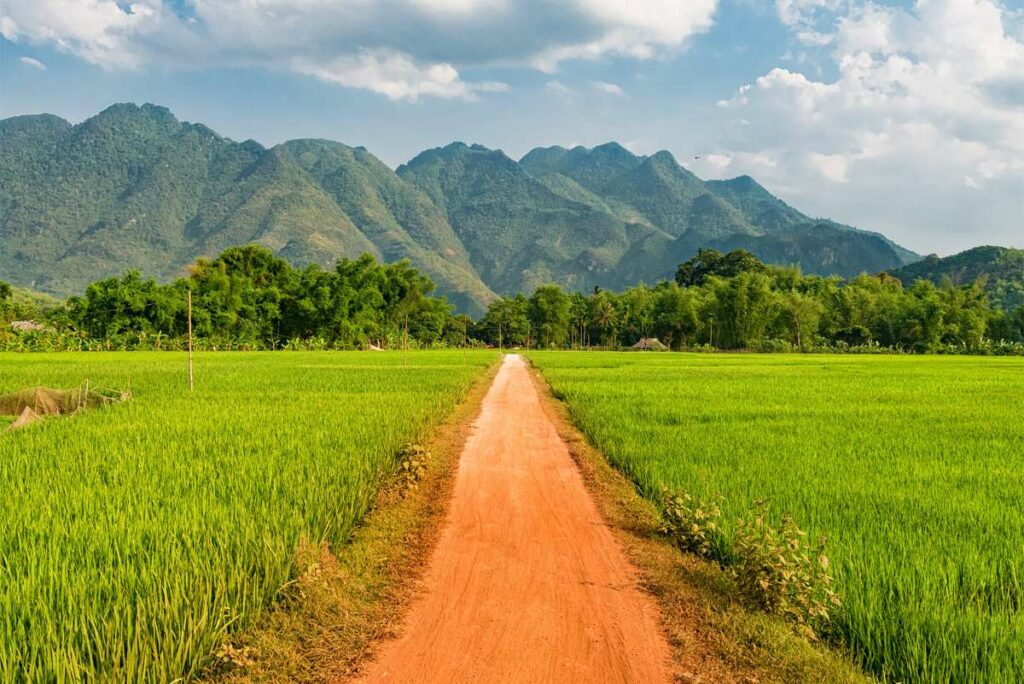About Hoa Binh Lake
Location & Basic facts
Hoa Binh Lake is located in Hoa Binh Province, about 70 kilometers southwest of Hanoi and 40 kilometers northeast of Mai Chau. It lies along the Da River and stretches across several districts including Da Bac, Cao Phong, and Tan Lac. The lake covers more than 100 kilometers in length, making it one of the largest man-made lakes in Vietnam.
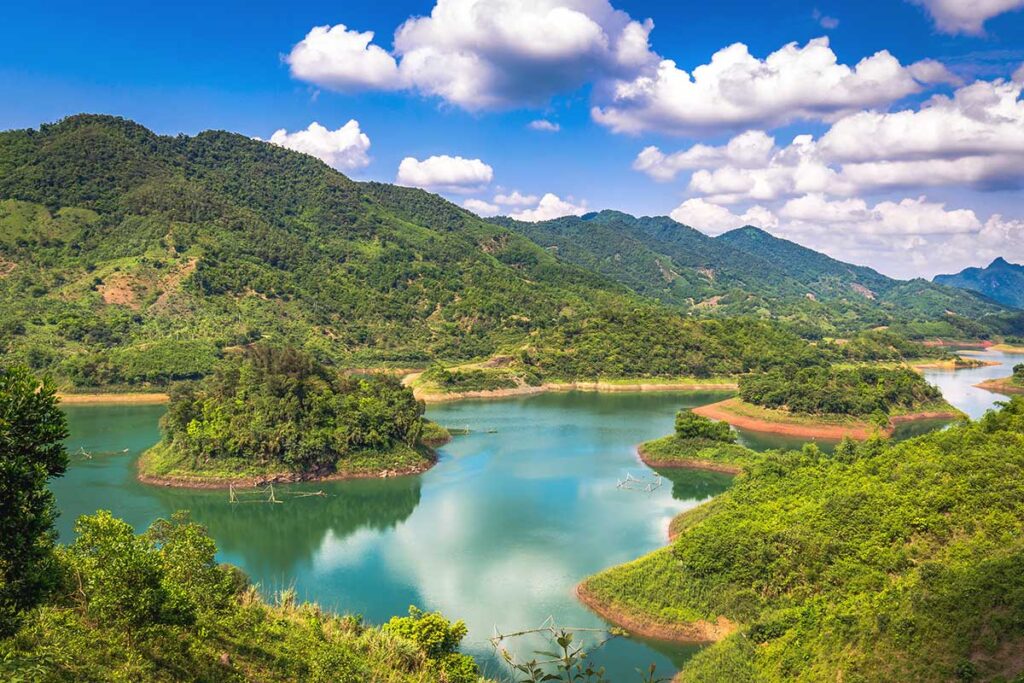
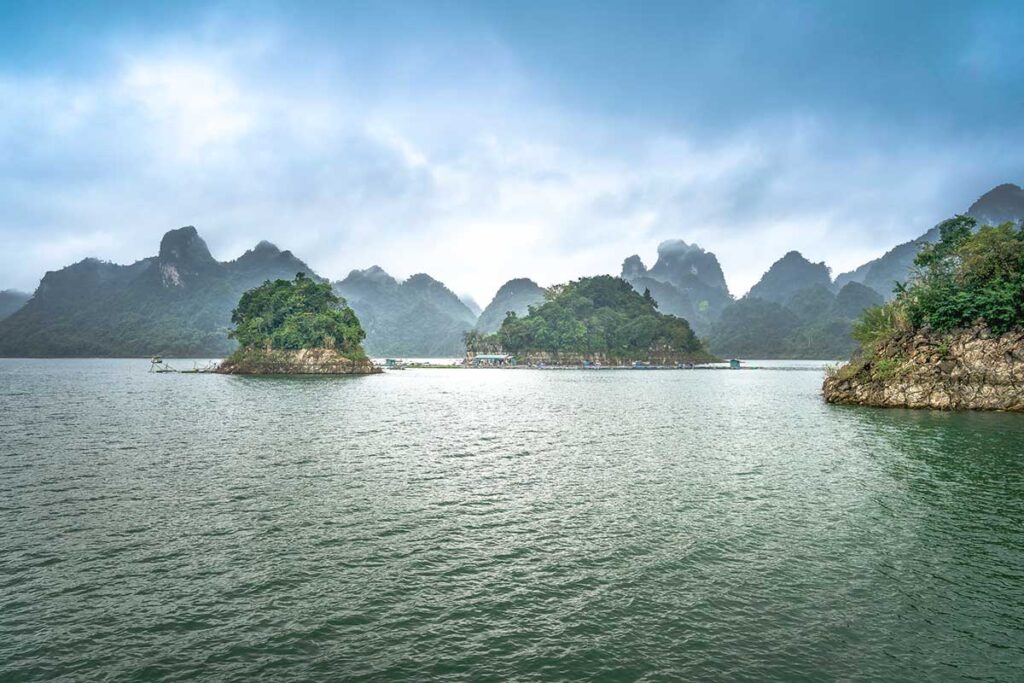
The surrounding landscape is a mix of forested mountains, limestone hills, and quiet water dotted with islands—many of which were once hilltops. Thanks to this dramatic scenery, Hoa Binh Lake is often nicknamed “Ha Long Bay in the mountains.”
How it was formed
Hoa Binh Lake was formed in the 1980s during the construction of the Hoa Binh Hydropower Plant, which was the largest of its kind in Southeast Asia at the time. To build the dam, the Da River was blocked and the valley behind it flooded, creating an artificial reservoir with a storage capacity of over 9 billion cubic meters.
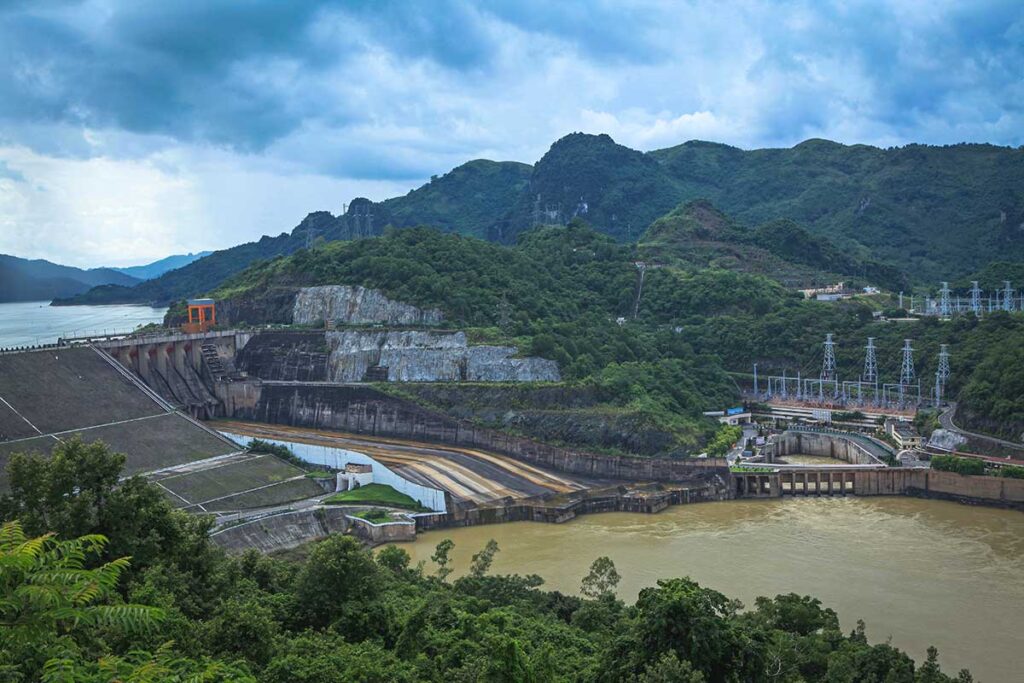
As the water rose, entire villages were relocated, and former hills became islands scattered across the lake. The dam still plays a vital role in supplying electricity and water to northern Vietnam.
From Energy to Eco-Tourism
While the lake’s original function was purely industrial, it has slowly become one of the key natural attractions in the region. The calm waters, scenic surroundings, and remote feel have turned it into a popular destination for travelers seeking peaceful nature experiences.
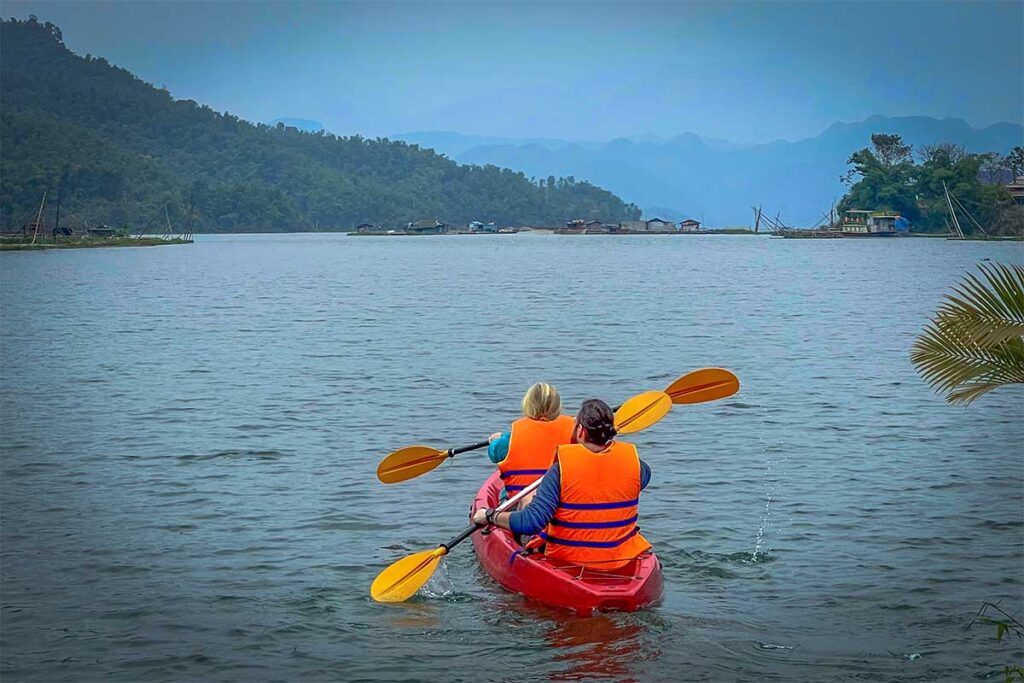
Many of the communities around the lake belong to ethnic Thai and Muong groups, who still live in stilt houses and maintain traditional lifestyles. This cultural backdrop, combined with the lake’s beauty, has led to the rise of eco-friendly tourism—especially small boat tours, kayaking, and relaxed overnight stays at local homestays and retreats.
Things to do at Hoa Binh Lake
1. Drive around the lake
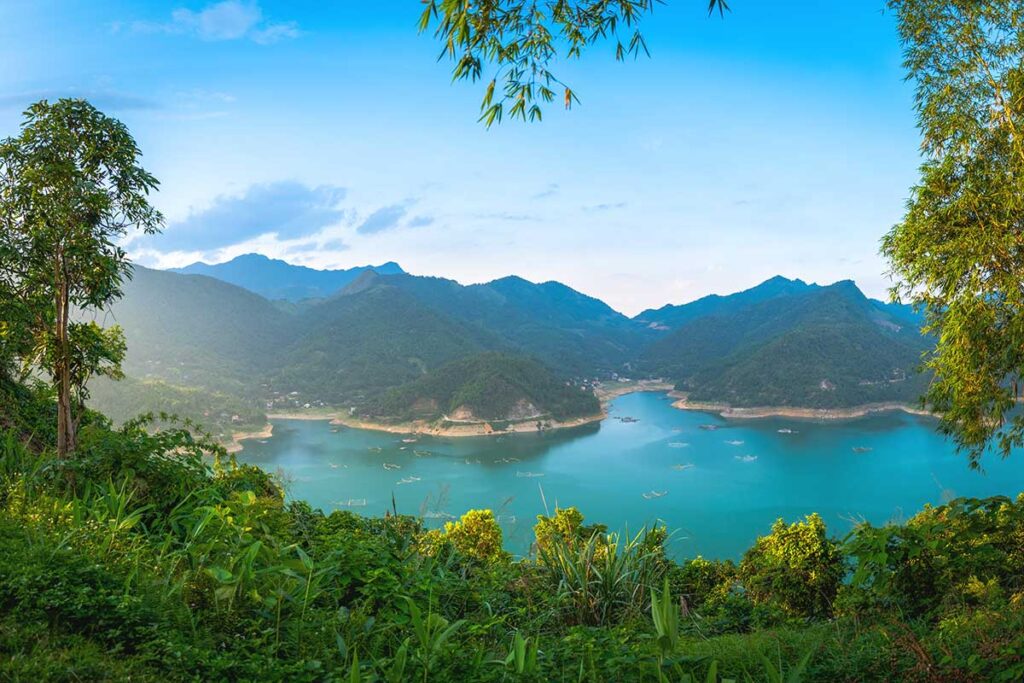
One of the best ways to experience Hoa Binh Lake is by driving along the quiet mountain roads that wind around the shoreline. These roads offer panoramic views over the water, especially in elevated areas where you can look down at the lake and its islands.
You’ll pass remote villages, lush forests, and scenic stops like Go Lao Waterfall and several boat piers along the way.
Pro tip: If you’re starting in Mai Chau, you can follow part of the Mai Chau Loop to include the lake, Go Lao Waterfall, and viewpoints all in one drive.
2. Boat tour on Hoa Binh Lake
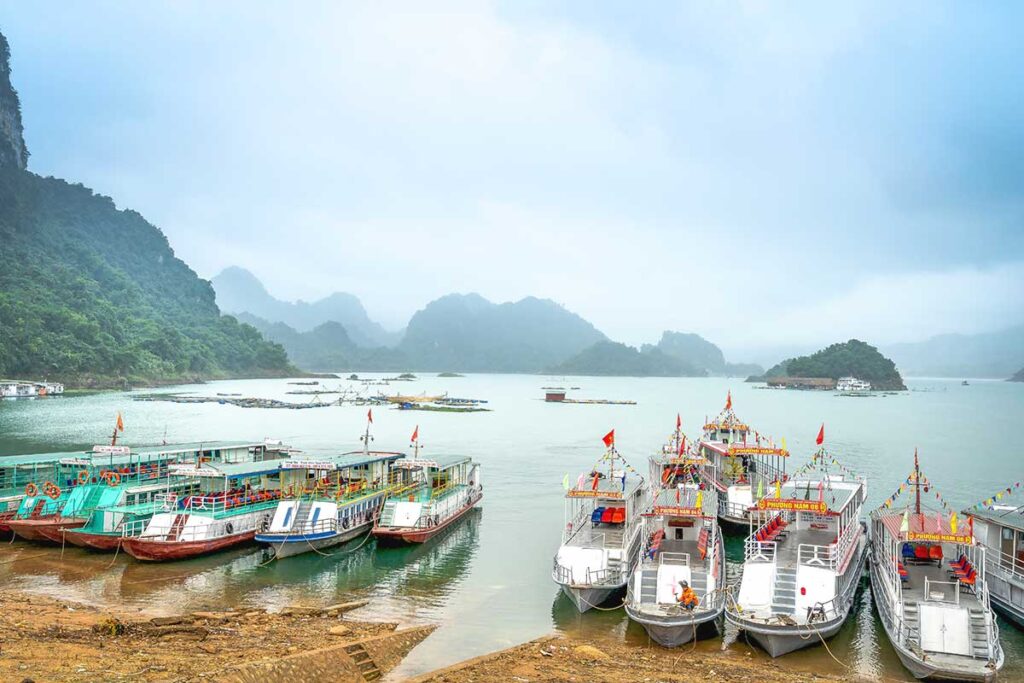
A boat tour is the most scenic way to explore the lake’s islands, inlets, and cultural spots. Popular highlights along the water include Thac Bo Cave and Pagoda, floating fish farms, limestone islets, and calm bays like Ngoi Hoa. Some longer trips may also pass Hoa Tien or Bung caves depending on the starting point.
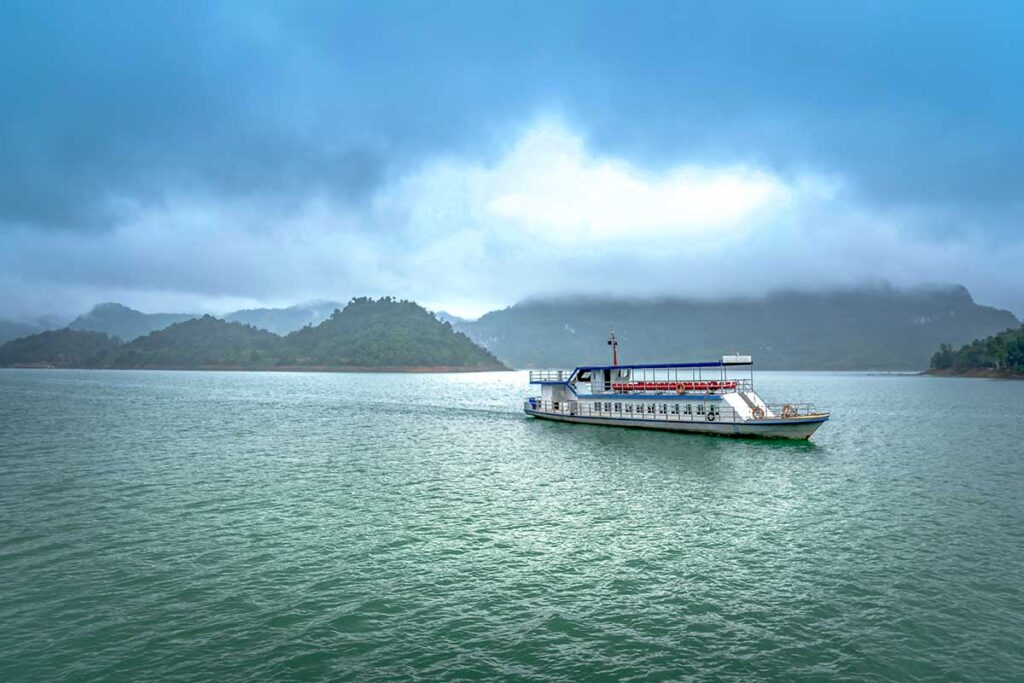
You can arrange boat tours through lakeside resorts like Mai Chau Hideaway or Ba Khan Village Resort, as well as at some local homestays. Most tours last around 2–3 hours and cost between 500,000 – 1,000,000 VND per boat, depending on the route and group size. Some include short stops at temples, caves, or fishing villages.
3. Kayaking on Hoa Binh Lake
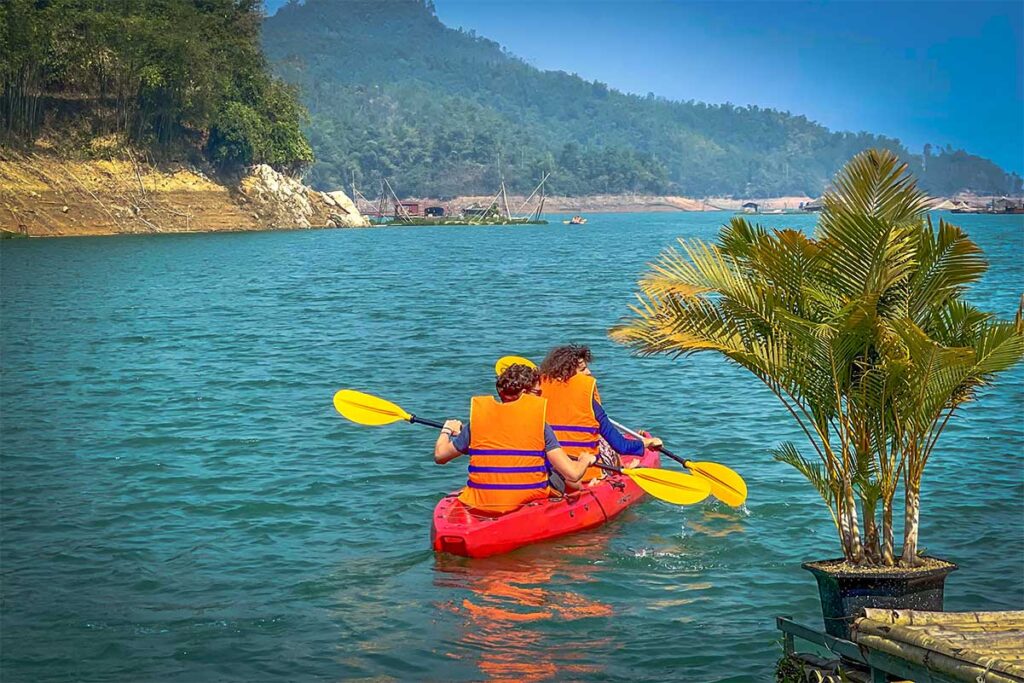
Kayaking is a great way to explore the calm waters of Hoa Binh Lake at your own pace. The most popular place to rent kayaks is the Mai Chau Floating House—a casual lakeside restaurant built on a wooden raft. It’s the closest and most convenient launch point from Mai Chau and offers both kayaks and stand-up paddleboards for rent, along with shaded seating and drinks to relax before or after your paddle.
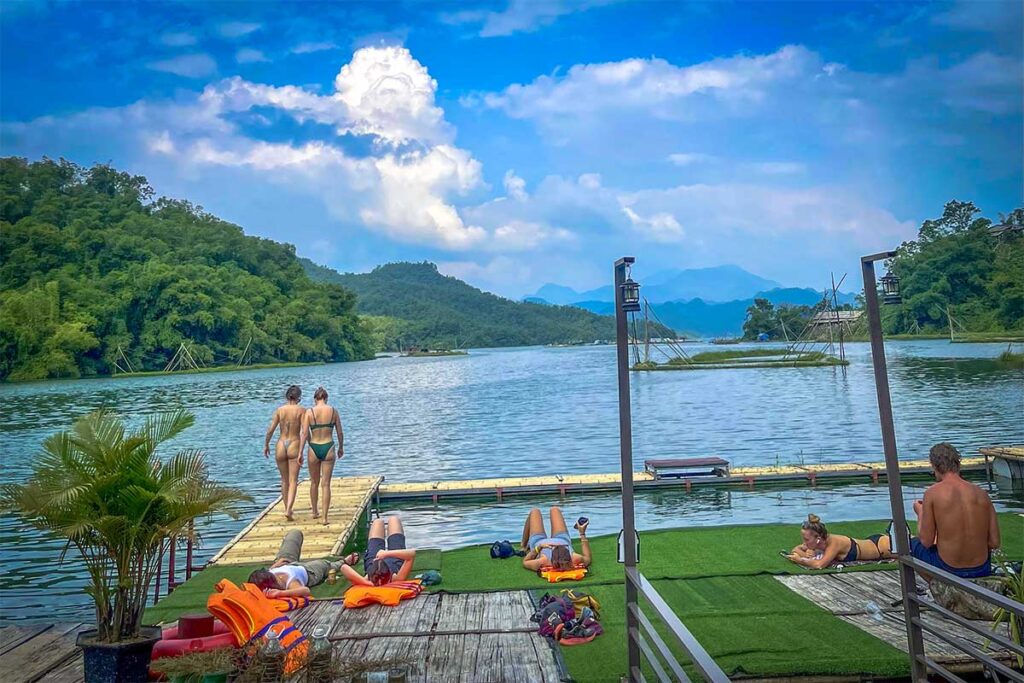
You can also find kayak rentals at a few retreats and resorts along the lake, like Mai Chau Hideaway and Ba Khan Village Resort, but these are typically limited to in-house guests.
The best time to kayak is in the late afternoon, when the sun begins to soften and the lake reflects the warm colors of sunset. On still days, swimming near the kayak launch points is also possible.
4. Take a dip at Go Lao Waterfall

Go Lao Waterfall is a small but scenic cascade located just a few minutes from the Mai Chau Floating House, making it an easy stop before or after kayaking. Surrounded by dense greenery and steep cliffs, it’s a peaceful spot to enjoy the sound of rushing water or take a swim in the clear, shallow pools below.
There’s a basic staircase leading down to the base of the falls. It’s not a big detour if you’re driving around the lake or coming from Mai Chau—it’s a nice refresh, especially on a hot day.
5. Visit ethnic minority villages
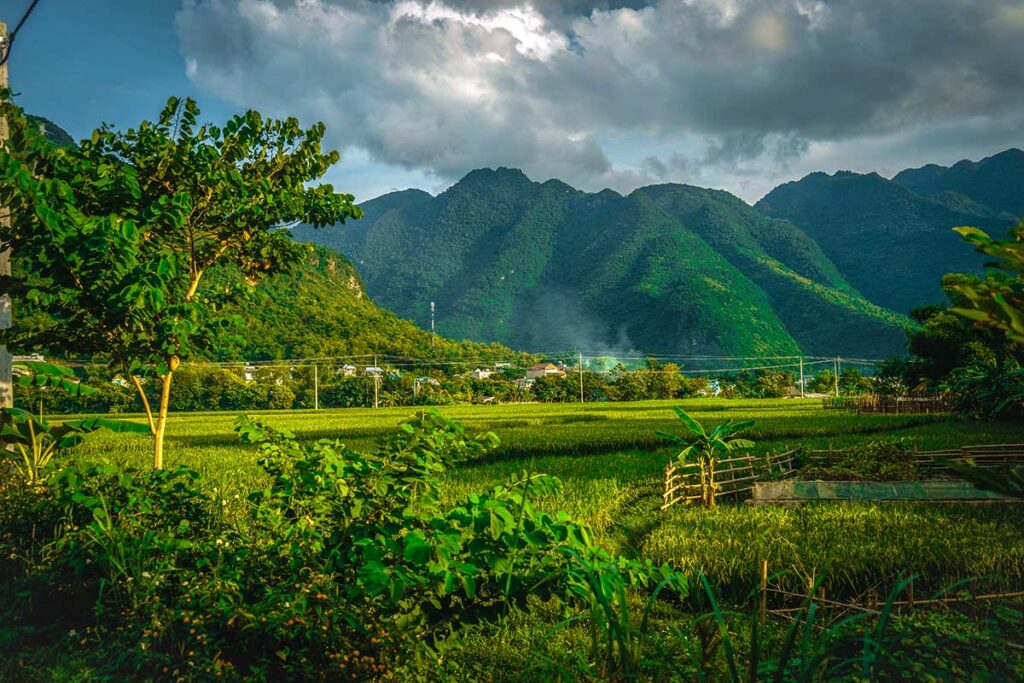
The area around Hoa Binh Lake is home to several ethnic Thai and Muong communities, known for their stilt houses, handmade textiles, and traditional way of life. Villages like Ba Khan, Ngoi Hoa, and Ke offer a glimpse into local culture with quiet roads, surrounding farmland, and mountain backdrops.

Some homestays in these villages also offer activities like cooking classes, weaving demonstrations, or community-based tourism experiences. Even just walking through these villages can be rewarding, especially if you’re interested in seeing daily life in rural Vietnam.
6. Visit Hoa Binh Hydropower Plant
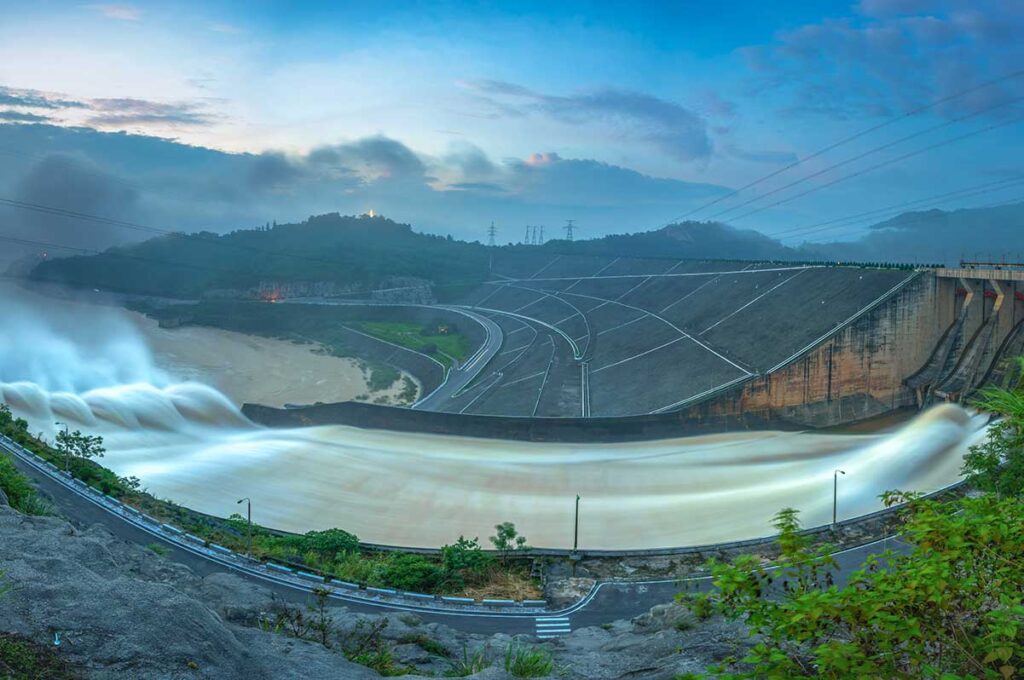
Located on the eastern edge of the lake near Hoa Binh City, the Hoa Binh Hydropower Plant played a major role in Vietnam’s industrial development after the war. While it’s still in operation today, parts of the site are open to visitors.
You can visit a small museum explaining the dam’s history and construction, and if you’re lucky, you might see the overflow gates open—an impressive sight when water is rushing through. It’s not worth going out of your way for, but it’s an interesting stop if you’re passing through the city on your way in or out.
7. Thac Bo Pagoda & Thac Bo Cave
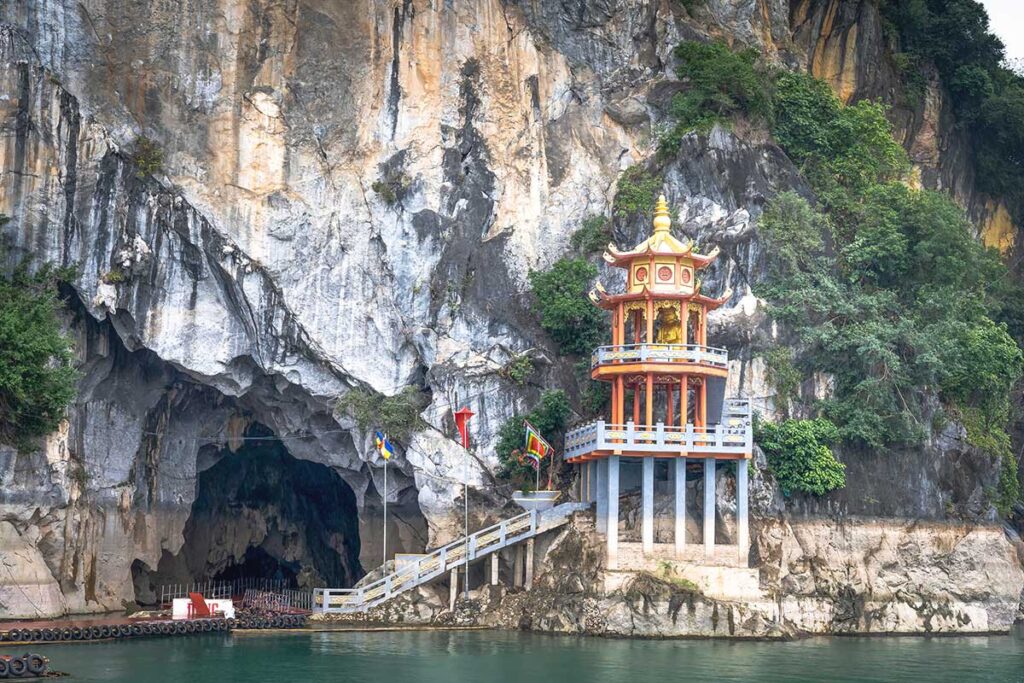
Thac Bo Pagoda and Thac Bo Cave are located on a peninsula in the middle of the lake and are often included in boat tours. The cave is around 100 meters long, with atmospheric lighting and natural stalactites and stalagmites. Right outside sits a peaceful pagoda overlooking the water, which draws both travelers and local pilgrims.
You can also reach the site by road via Ngoi Hoa village, but arriving by boat is the more scenic and popular option.
8. Stay overnight at the lake
Spending a night along the lake is more than just a place to sleep—it’s a chance to immerse yourself in the scenery. A handful of lakeside resorts and local homestays now dot the shoreline, offering peaceful stays far from busy tourist areas.
Many accommodations offer boat tours, kayak rentals, or even meals with a lake view. While services are limited compared to Mai Chau, the quiet setting and nature-focused experience make it well worth considering—especially if you want to wake up to misty lake views or paddle out at sunrise.
How to get to Hoa Binh Lake
From Hanoi to Hoa Binh Lake
There are a few easy ways to get from Hanoi to Hoa Binh Lake, depending on your budget and where exactly you’re staying around the lake.
- Private car with driver: The most convenient option is to book a private transfer straight from your hotel in Hanoi to your accommodation at the lake. Travel time is usually 2.5 to 3.5 hours, depending on where you’re staying (for example, Ba Khan is further than Ngoi Hoa).
- Limousine van + taxi: A more affordable option is to take a limousine van from Hanoi to Hoa Binh City. Several companies run these daily from central Hanoi (Old Quarter or My Dinh area). Once you reach the city, you can take a taxi or pre-arranged car to your resort or homestay around the lake.
- Motorbike: If you’re an experienced rider, you can also drive a motorbike from Hanoi. The roads are mostly good, though some sections near the lake can be steep or narrow. It’s a scenic ride, especially once you leave the main highway.
Visiting Hoa Binh Lake from Mai Chau
If you’re already staying in Mai Chau, the lake is very close—only about 10 to 15 km from the main valley area. This makes it easy to visit as a half-day trip.
- Car with driver: You can hire a local driver to take you to the lake, with stops at Go Lao Waterfall, the Mai Chau Floating House for kayaking or lunch, and some scenic viewpoints along the way.
- Motorbike rental: Another option is to rent a motorbike and drive yourself. The road is paved and the ride is short but includes some uphill sections.
This short trip is easy to fit into your Mai Chau itinerary, especially if you want to cool off with a swim or try kayaking for an hour or two.
Accommodation around Hoa Binh Lake
There are only a few resorts and local homestays scattered around Hoa Binh Lake, but more have popped up in recent years—and likely more will follow. Compared to Mai Chau, the area is much quieter, with fewer restaurants and limited services. That’s also the main reason to stay here: the lake offers a peaceful atmosphere, stunning views, and direct access to kayaking and boat tours.
That said, most people still prefer the rice field scenery and rural charm of Mai Chau, where there are more places to stay, more to eat, and easier access to services. Hoa Binh Lake is often visited on a half-day trip from there—but if you’re after lake views and calm, staying overnight here can be a great change of pace.
Mai Chau Hideaway Lake Resort
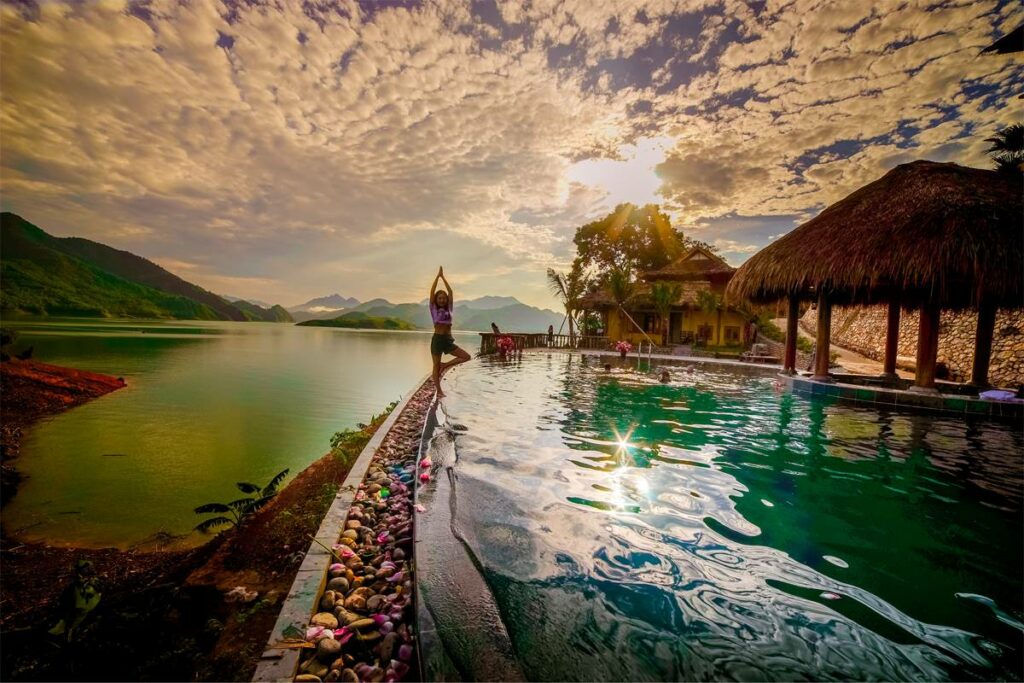
A popular lakeside resort with a panoramic setting, a large pool, and options to kayak or take a boat trip right from the property. The rooms are spacious, the views are the highlight, and the location is peaceful—though food and service can be a bit hit or miss.
Ba Khan Village Resort
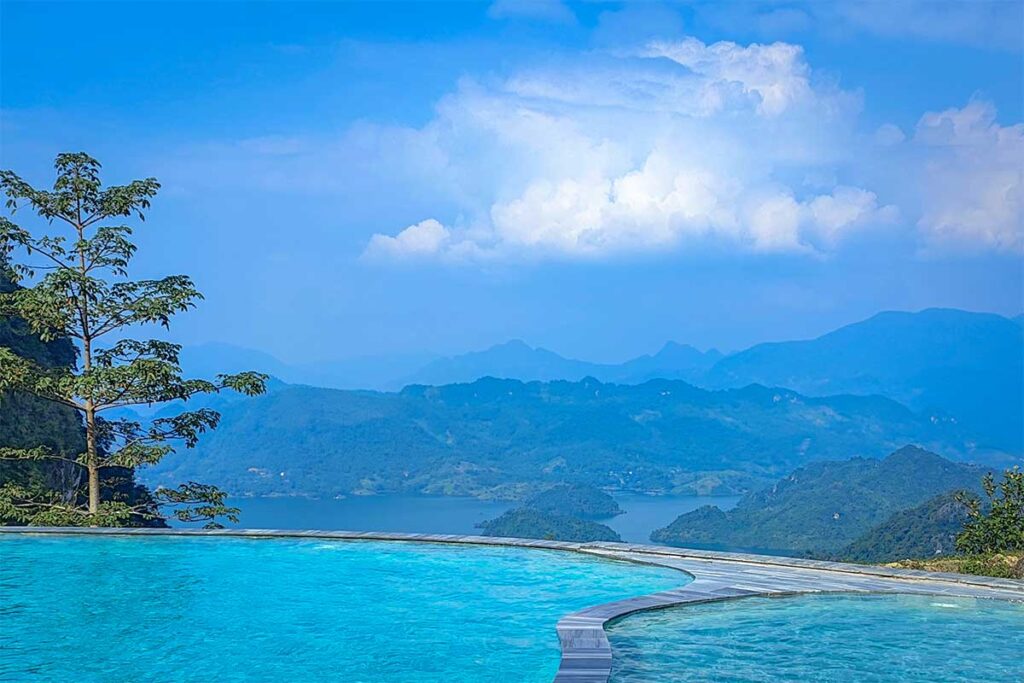
Known for its big pool, mountain views, and relaxed café setting. It’s remote and quiet, with traditional performances on weekends and helpful staff. Food is generally good, but limited for vegetarians. A solid pick for digital nomads or nature lovers.
Local Homestays
If you’re after something more immersive, staying in a traditional stilt house with a local family is the way to go. These homestays are usually simple—no aircon or fancy services—but full of character, with home-cooked meals and a real sense of connection.
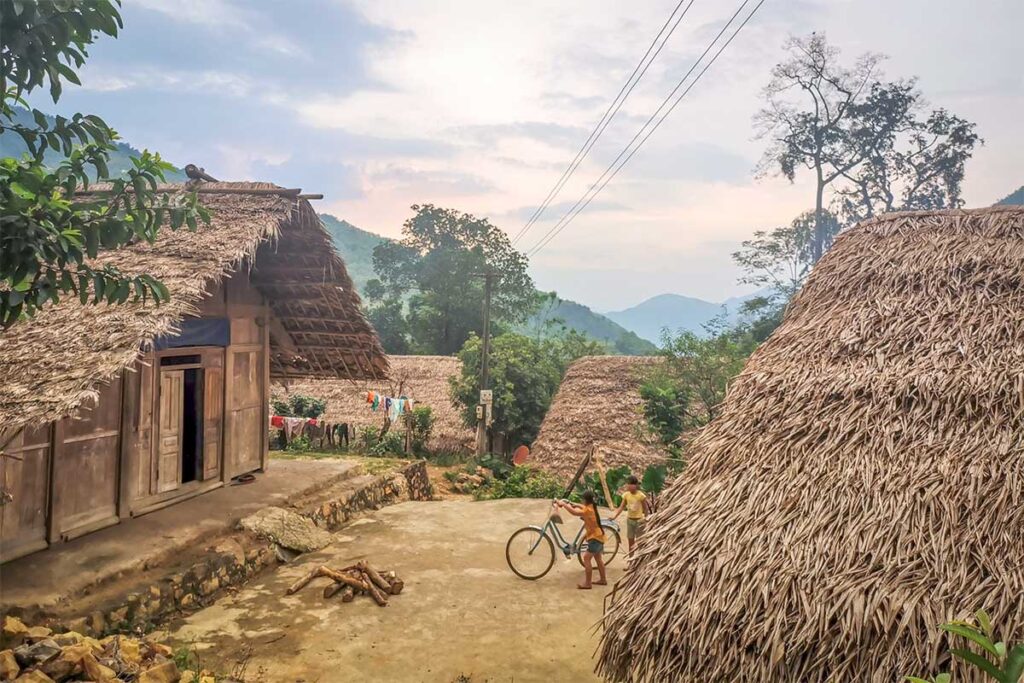
- Đinh Thu Homestay – A lakeside wooden house with shared sleeping areas, mountain views, and the option to go kayaking or take a short boat ride.
- Xuan Lan Homestay – A rustic village stay in a remote area, where the host cooks, guides, and shares stories. Expect basic dorm-style beds, herbal baths, and a warm welcome.
Best time to visit Hoa Binh Lake
Hoa Binh Lake can be visited year-round, as the scenery stays green and the lake remains calm throughout the seasons. Since there are no rice terraces or flower seasons like in Mai Chau, the landscape doesn’t change much during the year—but weather still makes a difference.
- Best months are March to May and September to November, when the weather is dry, temperatures are pleasant, and it’s ideal for activities like kayaking or boat tours.
- From December to February, the weather can be chilly and foggy. It’s still possible to visit, but not great for swimming or outdoor meals.
- The summer months (especially June to August) are hot and humid, and there can be occasional heavy rain, but it’s also a good time for swimming and sunset paddling if the weather cooperates.
There’s no “bad” time to come, but if you’re hoping to spend time on the water or relax outdoors, the dry season gives you the best chance.
Tips for visiting Hoa Binh Lake
Bring what you need
There are no shops or minimarts around most parts of the lake. Bring cash, mosquito spray, sunscreen, and any snacks or drinks you want during your stay.
Getting around
The area is best explored by car or motorbike. Cycling isn’t ideal—too hilly and spread out. If you’re staying overnight, ask your accommodation in advance about transport, as not all places have rental options or nearby taxis.
Kayaks and boat tours
Not every place offers them, so check before booking if that’s important to you. The Mai Chau Floating House is a good spot for kayaking even if you’re not staying nearby. Resorts like Mai Chau Hideaway and Ba Khan also arrange boat tours for guests.
Stay flexible
If you’re only visiting on a short trip from Mai Chau, keep in mind that the weather can affect boat or kayaking plans. If it’s cloudy or rainy, it’s still worth driving around the lake for the views and waterfall stops.


